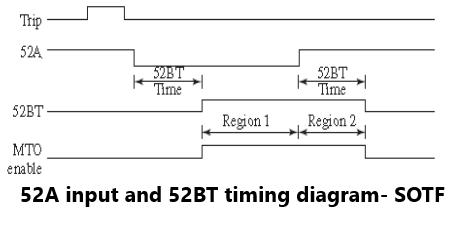Switch onto Fault (SOTF) Logic
Terms used in SOTF logic:
52A– follows a normally open auxiliary switch of the breaker.
52BT is a timer that enables the logic (designated MTO) shortly after the breaker opens and disables it shortly after the breaker closes.
POTT-Permissive Overreaching Transfer Trip (A teleprotection scheme used in power systems to quickly and reliably trip circuit breakers at both ends of a transmission line when a fault occurs)
MTO-Manual Trip Output or Manual Close Initiate

To providing dependable protection for close in three-phase faults with no, or low polarizing, voltage, switch-onto-fault logic may permit sensitive overreaching elements to be enabled for a short time after the line breaker is closed. The logic permits instantaneous tripping of the line breaker for end-of-line faults that would normally be cleared with zone 2 time delay. For the POTT scheme, the time required to echo the permissive signal to the remote terminal and back is greater than the time required to issue a trip by means of the switch-onto-fault logic.
During the time interval following breaker closure, the assertion of any element selected in the switch-onto-fault logic closes the trip output contacts, thereby enabling the switch-onto-fault protection. An example of the timing of the switch-onto-fault elements is shown in Figure. In this figure, 52A follows a normally open auxiliary switch of the breaker. 52BT is a timer that enables the logic (designated MTO) shortly after the breaker opens and disables it shortly after the breaker closes.
The MTO logic is enabled during the time periods labeled Region 1 and Region 2. During the Region 1 period, the MTO logic is enabled to protect the open line breaker. For line breaker tank faults, the relay can issue a trip signal required for breaker failure protection. Any time delay due to circuit breaker auxiliary contact opening is accounted for during Region 1. Region 2 is the period during which the MTO logic is performing the switch-onto-fault testing. The 52BT gives a permissive signal for breaker tripping during this time period.
SOTF Logic monitor:
Breaker status: Detects if the breaker just closed.
Current presence: High current after breaker closing may indicate a fault.
Voltage condition: If voltage is low or absent before closing, it might indicate the line is de-energized and faulty.
Time delay: A short delay (e.g., 100–200 ms) may be used to prevent nuisance tripping.
Why SOTF logic used in Electrical substation?
Immediate Fault Detection After Breaker Closing
If a breaker closes onto a line with an existing fault (e.g., during manual or automatic reclosing), traditional protection might take a few cycles to react.
SOTF detects the fault instantly at the moment of breaker closing and triggers a fast trip.
Prevent Equipment Damage
Closing onto a fault can cause high fault currents. Fast isolation helps protect transformers, CTs, breakers, and busbars.
Enhance System Stability
Quick fault clearing prevents voltage dips and power swings, improving system stability.
Backup for Line Protection
If main protection is not active (e.g., due to relay settings or communication issues), SOTF can act as an emergency protection.
